Our sheep barns are cleaned several times a day on a regular basis, especially over winter and prior to/during and after lambing. In the spring, through fall, the ewes and their lambs spend less time in the barn. In the summer, they sleep outside. Our ewes pick where they lamb. Lambs born on pasture are cleaned, trained, then their mothers move them into the barn before dusk. That's to avoid predators. We have birds of prey and coyotes in our vicinity. New straw is added after soiled straw is removed. It provides a rich fertilizer base for our bamboo and other landscape plants outside our sheep areas. Clean straw is put down in front of the barn as well, so as to avoid mud buildup. The entrance to the lambing barn is wide so our sheep don't have to travel one path. Our ewes stay fairly clean even though Oregon has very wet rainy weather.
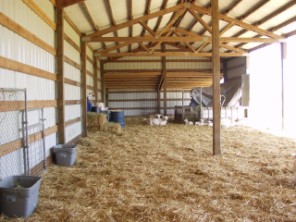
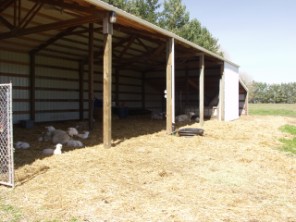
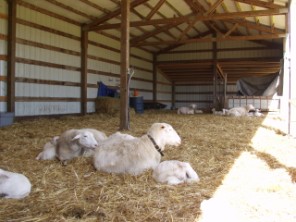
Our feed troughs are inspected at each feeding to ensure the troughs are clean. The water troughs are filled with fresh water daily. Complete water changes are done on an, as needed basis. Loose mineral is added fresh daily to clean bowls and is made available year round. We feed a complete loose mineral prior to lambing about 3 months out and up till weaning. We use a loose salt/selenium mix the other months.
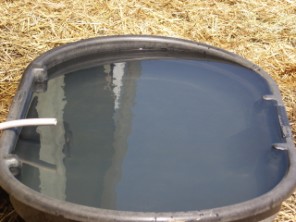
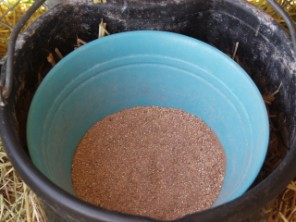
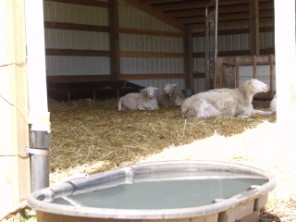
We started out with really good pasture. Over time our pastures have become depleted. We have lush abundance grass/forages in the spring but not enough over winter. It didn't make sense to add more sheep with too much grass. Nor did we want to alternate our sheep with cattle. Haying it was not an option, while we lacked the haying equipment. Renting or hiring it done was not an option, since equipment coming in from outside could bring in diseases. We are fully closed and can't take that risk. A cost share basis would mean the use of fertilizers and spray in our sheep pastures. We use NO sprays. NO commerical fertilizers and NO chemicals on any of our pastures. We don't spray any of our fruit or nut trees nor do we fertilize them other than what the sheep provide. We decided the best choice would be feeding alfalfa hay over the winter, which has required my constant search for clean hay that has been put up right. Sheep are sensitive to mold and mildew and pregnant ewes can abort. The alfalfa hay provides the protein and other nutrients the ewes need during pregnancy and lactation. Young lambs also require high protein for muscle growth. Our pasture is good and usually growing from March through July. We wean right after the pasture gets dry in the first heat, usually mid July. The lambs continue to eat the taller grasses while the ewes are good foragers and after weaning they go back to their normal weight while browsing. By fall, the ewes are ready again for breeding mid October. The grass goes dormant in the fall with cooler nights late September into October and serves as a good ground cover over winter during the cooler wet rainy season. This year we put our ewes out on pasture with no hay after one month of nursing their lambs and they have excellent body weight now after 4 months on pasture nursing their lambs, both ewes and lambs are all grassfed. The lambs are robust and healthy as well their mothers.
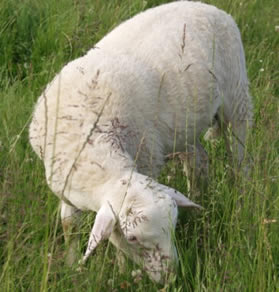
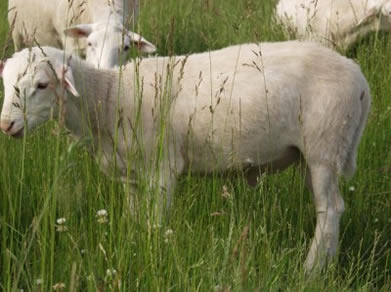
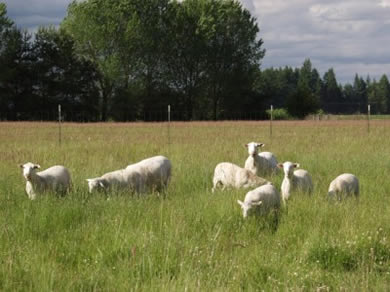
We give no shots, no wormers, no antibiotics or medications to any of our sheep. I attribute that to keeping a closed herd with no footrot/scald/diseases and enforcing a strong biosecurity protocol. We have no new animals coming in, so no diseases are being introduced into our flock. We don't use an intense grazing system which I believe helps break the worm cycle. Lambs develope their resistance to worms over the first year.
Read below the USDA
Standards for all grassfed. Go on their page with link provided to the
left if you would like to read more.
Grass Fed Marketing Claim Standards
Claim and Standard:
Grass (Forage) Fed – Grass and forage shall be the feed source consumed
for the lifetime of the ruminant animal, with the exception of milk consumed
prior to weaning. The diet shall be derived solely from forage consisting
of grass (annual and perennial), forbs (e.g., legumes, Brassica), browse,
or cereal grain crops in the vegetative (pre-grain) state. Animals cannot
be fed grain or grain byproducts and must have continuous access to pasture
during the growing season. Hay, haylage, baleage, silage, crop residue without
grain, and other roughage sources may also be included as acceptable feed
sources. Routine mineral and vitamin supplementation may also be included
in the feeding regimen. If incidental supplementation occurs due to inadvertent
exposure to non-forage feedstuffs or to ensure the animal’s well being
at all times during adverse environmental or physical conditions, the producer
must fully document (e.g., receipts, ingredients, and tear tags) the supplementation
that occurs including the amount, the frequency, and the supplements provided.